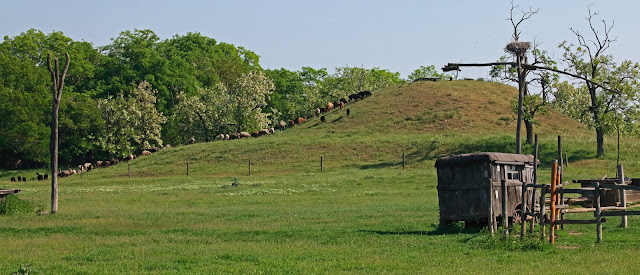Kurgans are iconic sacred sites of the Eurasian steppes. Besides their historical and cultural values, kurgans also have a considerable conservation importance. Kurgans act as refuges for grassland habitats and species in transformed landscapes. They act as biodiversity hotspots in the extended Central-Asian steppes, maintaining the populations of many grassland species which are typically confined to kurgans.
 |
| Filagória-kurgan |
The flora and fauna of the kurgans are threatened by several – predominantly anthropogenic – factors such as ploughing, building, soil excavation, presence of roads and encroachment of woody invasive species. For the latter the encroachment of the black locust (Robinia pseudoacacia) and the lycium (Lycium barbatum) are typical examples. These species often encroach the kurgans of the forest steppe region, and result in a considerable decrease in grassland species.
For the effective protection of the kurgans it is of a crucial importance to have up-to-date data on their current conservation status and on the factors threatening their cultural and natural values. This information can be a good basis for setting up effective conservation plans focusing both on the conservational and the cultural values. Although in some regions there are existing databases about kurgans, generally these databases allow only a limited access to the data for conservation managers, scientists or NGOs. They often record only a small proportion of the kurgans (generally only the huge and spectacular ones are involved into the databases).
That is why we established the Eurasian Kurgan Database (http://openbiomaps.org/projects/kurgan), which aims to collect and provide basic data for setting up effective nature conservation management plans focusing on kurgan protection and also to represent the cultural values confined to the kurgans. We collect and provide basic information relevant for conservation and management, and can be collected even by non-professionals. The attributes to collect were selected considering that data providers are not necessarily professional biologists or geographers; thus only such data is collected which can be recognised or estimated without any previous professional training.
The database provides possibility to collect two types of data regarding the kurgans. The two levels differ in the complexity of the data provided. The ‘basic data form’ can be used for recording data about the name and the geographical position of the kurgans. There is a possibility to record more detailed data by the ‘complex data form’ which involves columns on the physical, biological and cultural attributes of the kurgans and on the factors threatening their existence.
In order to support the uploaders, we prepared two tutorial videos which can be seen here.
The main functions of the database:
- To provide a widely available, open access database for collecting and providing data on the kurgans of Eurasia. The locations are freely accessible without registration. Detailed data is also freely accessible, but for accessing it registration is needed (for registering, please send an email to the debalazs@gmail.com email address).
- To provide information for planning nature conservation activities.
- By providing possibility to record repeated observations the database can provide a basis for monitoring purposes (e.g. detecting the changes in the cover of woody species).
- The database also provides a public repository for cultural values (such as cultural buildings, tales, sagas) confined to the kurgans.
 |
| At the moment we have 362 data points in Eurasia. Promising start, but we have to go further. :) |
 |
| Data points from Hungary |
In order to draw attention on the present conservation status of the kurgans across Eurasia we aim to publish a synthesis paper using the data from the database. The planned publication aims to give a comprehensive overview on the current land cover, threatening factors present on and the cultural values associated to the kurgans of the different regions of a wide geographical range. According to the terms and conditions of the Eurasian Kurgan Database data contributors who provided at least 5% of the available data on the complex data form will be offered a co-authorship in the forthcoming publications (Further details in the „Terms and conditions” of the database).
Please if you are interested in taking part in the data collection and publication, send an email to the debalazs@gmail.com email address.
Citation of the Database:
Deák B. (2019): Eurasian Kurgan Database. doi: 10.18426/10.18426/obm.3mbbectm2bmg
Many thanks to Miklós Bán and Ferenc Báthori for their lot of work during the establishment and development of the Database. Csaba Tóth, Gábor Szilágyi, Ádám Bede, Orsolya Valkó, Laura Godó, Gábor Sramkó, Gyula Szabó and Iva Apostolova provided valuable comments, suggestions and data for the Database.

No comments:
Post a Comment